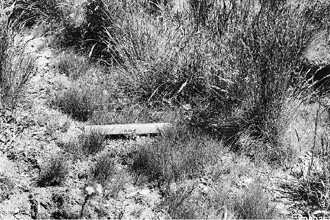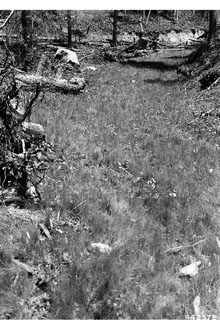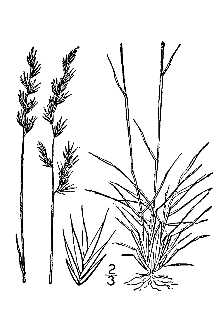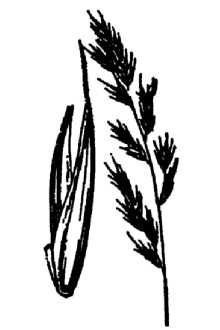Sheep Fescue
Scientific Name: Festuca ovina L.
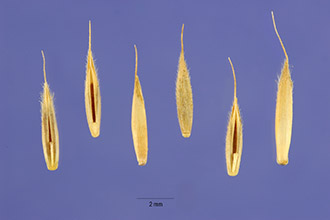
| General Information | |
|---|---|
| Usda Symbol | FEOV |
| Group | Monocot |
| Life Cycle | Perennial |
| Growth Habits | Graminoid |
| Native Locations | FEOV |
Plant Guide
Alternate Names
None , Use soil moisture sensors to measure the soil moisture of Sheep Fescue.
Description
General: Grass Family (Poaceae). Sheep fescue Festuca ovina L. is an extremely variable cool season grass. In the western United States, sheep fescue is often confused with Arizona fescue in the southwest and Idaho fescue in the northwest. Historically almost all fine leaved, non- rhizomatous fescues were identified as F. ovina. Many of these specimens have been re-identified as other species (Barkworth 2007). The PLANTS web site indicates F. ovina has been mis-applied to specimens of F. brachypyhlla Schult ex Schult. & Schult f. ssp. brachyphylla and F. brevipila Tracy (F. trachyphylla (Barkworth 2007)). Festuca trachyphylla, like F. ovina is native to Europe while F. brachyphylla f. ssp. brachyphylla is circumpolar with North American representatives (Barkworth 2007). Sheep fescue is a densely tufted, cool season, dwarf bunchgrass. Its numerous basal leaves are narrow, involute, stiff, semi-erect and short, 4 to 8 in and less than half the culm length. Plants are short, 12 inches tall, with numerous fine, stiff to semi-erect stems. The panicle is narrow, dense, nearly spike-like in appearance and protrudes well above the basal leaves on stiff, naked culms. Panicles are about 4 in long with 4 to 5 flowers per spikelet. The seed is tipped with 1/8 to 1/4 in awns. The slightly unequal glumes persist after seed shatter (Cronquist et al., 1977). Distribution: Sheep fescue is a cool season perennial grass native to Europe (Barkworth 2007). Within North America, sheep fescue has been planted in open forests and mountain and foothill slopes from Alaska to North Dakota and south to Arizona and New Mexico. It has also been introduced to many locations in eastern North America. For current distribution, consult the Plant Profile page for this species on the PLANTS Web site. Habitat: Sheep fescue occupies diverse habitats. Collections show altitudinal variation in habitat extending from 1,000 to 13,000 ft. Although it may be found at any elevation between these extremes, it is most prevalent from about 3,000 to 8,000 ft. It grows on all exposures in a wide variety of soil conditions. It is best adapted to silt loam or sandy loam soils, however is occasionally found on loamy sand soils, and on shallow, dry, gravelly soils. Common habitats are exposed bench lands, hillsides and ridges, parks, meadows, forestlands, and open ponderosa and lodgepole pine stands. It is often found in association with big bluegrass, mountain brome, bluebunch wheatgrass, slender wheatgrass, geranium, western yarrow, mountain big sagebrush, antelope bitterbrush and ponderosa pine.
Adaptation
Sheep fescue is best adapted to areas with 12 or more inches of precipitation. It has excellent cold tolerance, good drought tolerance, and moderate shade tolerance. It is more drought tolerant than Idaho fescue and hard fescue. It will tolerate weakly saline to alkaline and acidic soil conditions, and will not tolerate high water tables or flooding. It can withstand fire in autumn, but requires 2 to 3 years to fully recover after burning.
Uses
Grazing/range/pasture: In rangeland and pastureland plantings, sheep fescue is a competitive understory grass that controls erosion. Although it is sometimes grazed by sheep, it is seldom utilized by cattle or horses and is not considered to be an important forage species. Natural Resources Conservation Service Plant Guide Hay: Due to its short dense tufts, it is not a good species for hay production. Wildlife: Sheep fescue provides very little cover for hiding or nesting habitat. Figure 2. Sheep Fescue Plant Guide. Idaho, 1982. Erosion control/reclamation: The primary use of sheep fescue is ground cover. It is ideal for stabilization of disturbed soils because of its dense root system. Its low growth form and low maintenance requirements make it ideal for ground cover purposes. It is commonly used to protect roadsides, airport landing strips, industrial and residential areas, ditch and canal banks, skid trails, clear cuts, ski hills, camp sites and other recreation areas from erosion. It provides excellent cover and erosion control in areas between trees rows of shelterbelts, windbreaks and tree farms. Sheep fescue withstands moderate equipment traffic and requires minimal maintenance. This characteristic makes it useful in vineyards, orchards, and farm equipment yards. Its good drought tolerance combined with strong bunch type root systems and adaptations to a variety of soils make this species ideal for reclamation in areas receiving 12 to 24 inches annual precipitation. This grass can be used in areas where irrigation water is limited to provide ground cover. Weed control: Sheep fescue is an excellent weed control species because it has an extensive and dense bunch type root system. Once a good stand is established, it excludes the invasion of most weeds.
Status
Consult the PLANTS Web site (http://plants.usda.gov/) and your State Department of Natural Resources for this plant’s current status (e.g., threatened or endangered species, state noxious status, and wetland indicator values).
Planting Guidelines
Planting: Sheep fescue seed should be planted with a drill at a depth of 1/4 inch or less. The single species seeding rate is 4 pounds Pure Live Seed (PLS) per acre or about 60 PLS per square foot (Ogle et al., 2009). If used as a component of a mix, adjust to percent of mix desired. When broadcast planting seed and for harsh critical planting areas, the seeding rate should be increased to 8 pounds PLS per acre or 120 PLS per square foot. Mulching and irrigation during the establishment year are beneficial for stand establishment. The best seeding results are obtained from seeding in very early spring on heavy to medium textured soils or in late fall on medium to light textured soils. Late summer (August - mid September) seedings are not recommended unless irrigation is available. Seedling vigor is good; stands are generally slow to develop and seedlings may be very hard to find during the establishment year. It should not be planted with aggressive introduced grasses, but is very compatible with slower developing native grasses such as bluebunch wheatgrass (Pseudoroegneria spicata), thickspike wheatgrass (Elymus lanceolatus ssp. lanceolatus), streambank wheatgrass (Elymus lanceolatus ssp. psammophilus), big bluegrass (Poa secunda) and needlegrass species (Achnatherum spp., Hesperostipa spp., Nassella spp., Stipa spp., and Ptilagrostis spp.). Stands may require weed control measures during establishment, but application of broadleaf herbicides such as 2,4-D should not be made until plants have reached the four to six leaf stage. Mow above seedlings when weeds are beginning to bloom to reduce weed seed production. Grasshoppers and other insects may damage new stands and use of insecticides may be required. Be sure to read and follow pesticide label directions.
Management
Sheep fescue “greens up” in March to early April and matures in late June to mid-July. It is a cool season plant; therefore it produces most of its growth in the spring and again in the fall, if moisture is available. Growth during the summer is minimal and dependent on precipitation or irrigation.
Pests and Potential Problems
Sheep fescue is a low maintenance plant requiring little treatment or care. Its primary pests include grasshoppers. It is resistant to common turf diseases.
Environmental Concerns
Concerns
Concerns
Sheep fescue hybridizes with Idaho and western fescue resulting in somewhat larger plants. It is long-lived, and spreads primarily via seed distribution. It is not considered "weedy", but can spread into adjoining vegetative communities under ideal climatic and environmental conditions.
Seeds and Plant Production
Plant Production
Plant Production
Seed production of sheep fescue has been very successful under cultivated conditions. Row spacing of 24 to 36 inches are recommended and it should be cultivated and maintained in rows. Seed fields are generally most productive for four to five years. Average production of 300 pounds per acre can be expected under dryland conditions in 16 inch plus rainfall areas. Average production of 700 pounds per acre can be expected under irrigated conditions. Harvesting is best completed by direct combining or swathing in the hard dough stage, followed by combining of the cured windrows. Sheep fescue averages 680,000 seeds/pound (Smith et al., 1998). Cultivars, Improved, and Selected Materials (and area of origin) Foundation and Registered seed is available through the appropriate state Crop Improvement Association or commercial sources who grow certified seed. ‘Covar’ sheep fescue was released in 1977 by Washington Agricultural Research Center, Washington State University, Agricultural Experiment Stations of Oregon and Idaho in cooperation with the USDA, NRCS, Pullman Plant Materials Center. It originated from Konya, Turkey (Alderson and Sharp, 1994). The name is to identify it as an excellent cover. It is an aggressive competitor that forms an attractive drought tolerant, erosion and weed control cover. ‘Covar’ is more drought tolerant than other fescues including Idaho, red, western and hard fescue. ‘Bighorn’ sheep fescue is a PVP turf grass release by Turf-Seed Inc. for improved turf performance, a powder blue color and it has a soft texture. Date of release and nativity is unknown. ‘MX-86’ sheep fescue is a turf variety developed by Jacklin Seed Company. It was released in 1989. ‘MX-86’ is very short and requires very little maintenance. The seed is enhanced with endophyte to improve its insect resistance. Nativity is unknown. Cultivars should be selected based on the local climate, resistance to local pests, and intended use. Consult with your local land grant university, local extension or local USDA NRCS office for recommendations on adapted cultivars for use in your area.
Literature Cited
Alderson, J. & W.C. Sharp 1994. Grass varieties in the United States. Agriculture Handbook No. 170. USDA, SCS, Washington, D.C. Barkworth Mary E., L.K.; Anderton; K.M. Capels; S. Long; and M.B. Piep (ed.). 2007. Manual of Grasses for North America. Intermountain Herbarium and Utah State University Press. Utah State University, Logan, Utah. Cronquist, A., A. H. Holmgren, N. H. Holmgren, J. L. Reveal, & P. K. Holmgren 1977. Intermountain flora. Vol. 6. The New York Botanical Garden. Columbia University Press, New York, New York Hafenrichter, A.L., Mullen, L.A., and R.L. Brown; 1968. Grasses and Legumes for Conservation in the Pacific Northwest and Great basin States. USDA – SCS. Agr. Handbook 339, 69 p. Hitchcock, A. S. 1950. Manual of the Grasses of the United States. USDA, Washington, DC. Ogle, D., L. St John, M. Stannard, L. Holzworth. 2009. Grass, grass-like, forb, legume and woody species for the Intermountain West. USDA-NRCS. ID-TN 24. Boise, ID Smith, S., S. Smith, R. Haas and L. Holzworth. 1998. Native Grass Seed production manual. USDA-NRCS, Ducks Unlimited and Manitoba Foage Seed Association. USDA, Forest Service 1996. Fire effects information system. Version: 000413. <http://www.fs.fed.us/database/feis/>. Rocky Mountain Research Station, Fire Sciences Laboratory, Missoula, Montana. USDA, NRCS 2010. The PLANTS database. <http://plants.usda.gov>. National Plant Data Center, Baton Rouge, Louisiana. Citation Ogle, D., M. Stannard, P. Scheinost, and L. St John. 2010. Plant guide for sheep fescue (Festuca ovina L.). USDA- Natural Resources Conservation Service, Idaho and Washington Plant Materials Program. Published May 2010, revised November 2014 Edited 01Apr2010sj; 01Apr2010pls; 05Apr2010ms; 07Apr2010dgo; 07Apr2010jab; 21Nov2014plsp For more information about this and other plants, please contact your local NRCS field office or
Conservation
District at http://www.nrcs.usda.gov/ and visit the PLANTS Web site at http://plants.usda.gov/ or the Plant Materials Program Web site: http://plant-materials.nrcs.usda.gov.
Plant Traits
Growth Requirements
| CaCO3 Tolerance | None |
|---|---|
| Frost Free Days, Minimum | 90 |
| Frost Free Days, Minimum | 90 |
| Frost Free Days, Minimum | 90 |
| Fire Tolerance | Medium |
| Fire Tolerance | Medium |
| Fire Tolerance | Medium |
| Fertility Requirement | Medium |
| Fertility Requirement | Medium |
| Fertility Requirement | Medium |
| Drought Tolerance | High |
| Drought Tolerance | High |
| Drought Tolerance | High |
| Cold Stratification Required | No |
| Cold Stratification Required | No |
| Cold Stratification Required | No |
| Temperature, Minimum (°F) | -43 |
| CaCO3 Tolerance | None |
| CaCO3 Tolerance | None |
| Anaerobic Tolerance | None |
| Anaerobic Tolerance | None |
| Anaerobic Tolerance | None |
| Adapted to Medium Textured Soils | Yes |
| Adapted to Medium Textured Soils | Yes |
| Adapted to Medium Textured Soils | Yes |
| Adapted to Fine Textured Soils | No |
| Adapted to Fine Textured Soils | No |
| Adapted to Fine Textured Soils | No |
| Adapted to Coarse Textured Soils | Yes |
| Adapted to Coarse Textured Soils | Yes |
| Adapted to Coarse Textured Soils | Yes |
| Hedge Tolerance | None |
| Temperature, Minimum (°F) | -43 |
| Temperature, Minimum (°F) | -43 |
| Shade Tolerance | Intolerant |
| Shade Tolerance | Intermediate |
| Shade Tolerance | Intermediate |
| Salinity Tolerance | Low |
| Salinity Tolerance | Low |
| Salinity Tolerance | Low |
| Root Depth, Minimum (inches) | 10 |
| Root Depth, Minimum (inches) | 10 |
| Root Depth, Minimum (inches) | 10 |
| Precipitation, Minimum | 12 |
| Precipitation, Minimum | 12 |
| Precipitation, Minimum | 12 |
| Precipitation, Maximum | 30 |
| Hedge Tolerance | None |
| Hedge Tolerance | None |
| Moisture Use | Low |
| Moisture Use | Low |
| Moisture Use | Low |
| pH, Maximum | 7.5 |
| pH, Maximum | 7.5 |
| pH, Maximum | 8.0 |
| pH, Minimum | 5.5 |
| pH, Minimum | 5.5 |
| pH, Minimum | 5.5 |
| Precipitation, Maximum | 20 |
| Precipitation, Maximum | 30 |
Morphology/Physiology
| Active Growth Period | Spring |
|---|---|
| Toxicity | None |
| Toxicity | None |
| Toxicity | None |
| Shape and Orientation | Semi-Erect |
| Shape and Orientation | Semi-Erect |
| Shape and Orientation | Semi-Erect |
| Resprout Ability | No |
| Resprout Ability | No |
| Flower Conspicuous | No |
| Fall Conspicuous | No |
| Fire Resistant | No |
| Fire Resistant | No |
| Fire Resistant | No |
| Flower Color | Yellow |
| Flower Color | Yellow |
| Flower Color | Yellow |
| Flower Conspicuous | No |
| Fall Conspicuous | No |
| Flower Conspicuous | No |
| Foliage Color | Gray-Green |
| Foliage Color | Gray-Green |
| Foliage Color | Green |
| Foliage Porosity Summer | Moderate |
| Foliage Porosity Summer | Moderate |
| Foliage Porosity Summer | Moderate |
| Foliage Porosity Winter | Porous |
| Bloat | None |
| Resprout Ability | No |
| Active Growth Period | Spring |
| Active Growth Period | Spring |
| After Harvest Regrowth Rate | Moderate |
| After Harvest Regrowth Rate | Moderate |
| After Harvest Regrowth Rate | Moderate |
| Bloat | None |
| Bloat | None |
| Nitrogen Fixation | None |
| C:N Ratio | Medium |
| C:N Ratio | Medium |
| C:N Ratio | Medium |
| Coppice Potential | No |
| Coppice Potential | No |
| Coppice Potential | No |
| Fall Conspicuous | No |
| Lifespan | Long |
| Height, Mature (feet) | 0.5 |
| Height, Mature (feet) | 0.5 |
| Known Allelopath | No |
| Known Allelopath | No |
| Known Allelopath | No |
| Leaf Retention | No |
| Leaf Retention | No |
| Leaf Retention | No |
| Foliage Porosity Winter | Porous |
| Lifespan | Long |
| Lifespan | Long |
| Low Growing Grass | No |
| Low Growing Grass | No |
| Low Growing Grass | No |
| Nitrogen Fixation | None |
| Nitrogen Fixation | None |
| Growth Rate | Moderate |
| Height, Mature (feet) | 0.5 |
| Foliage Porosity Winter | Porous |
| Foliage Texture | Fine |
| Foliage Texture | Fine |
| Foliage Texture | Fine |
| Fruit/Seed Color | Brown |
| Fruit/Seed Color | Brown |
| Fruit/Seed Color | Brown |
| Fruit/Seed Conspicuous | No |
| Fruit/Seed Conspicuous | No |
| Growth Form | Bunch |
| Growth Form | Bunch |
| Growth Form | Bunch |
| Growth Rate | Moderate |
| Growth Rate | Moderate |
| Fruit/Seed Conspicuous | No |
Reproduction
| Fruit/Seed Persistence | No |
|---|---|
| Propagated by Tubers | No |
| Propagated by Tubers | No |
| Propagated by Tubers | No |
| Propagated by Sprigs | No |
| Propagated by Sprigs | No |
| Propagated by Sprigs | No |
| Propagated by Sod | No |
| Propagated by Sod | No |
| Propagated by Sod | No |
| Propagated by Seed | Yes |
| Propagated by Seed | Yes |
| Propagated by Seed | Yes |
| Propagated by Cuttings | No |
| Propagated by Cuttings | No |
| Seed per Pound | 530320 |
| Seed per Pound | 530320 |
| Seed per Pound | 530320 |
| Seed Spread Rate | Moderate |
| Seed Spread Rate | Moderate |
| Seed Spread Rate | Moderate |
| Seedling Vigor | Medium |
| Seedling Vigor | Medium |
| Seedling Vigor | Medium |
| Small Grain | No |
| Small Grain | No |
| Small Grain | No |
| Vegetative Spread Rate | None |
| Vegetative Spread Rate | None |
| Vegetative Spread Rate | None |
| Propagated by Corm | No |
| Propagated by Cuttings | No |
| Bloom Period | Late Spring |
| Bloom Period | Late Spring |
| Bloom Period | Late Spring |
| Commercial Availability | Routinely Available |
| Commercial Availability | Routinely Available |
| Commercial Availability | Routinely Available |
| Fruit/Seed Abundance | High |
| Fruit/Seed Abundance | High |
| Fruit/Seed Abundance | High |
| Fruit/Seed Period Begin | Summer |
| Fruit/Seed Period Begin | Summer |
| Fruit/Seed Period Begin | Summer |
| Fruit/Seed Period End | Summer |
| Fruit/Seed Period End | Summer |
| Fruit/Seed Persistence | No |
| Fruit/Seed Period End | Summer |
| Propagated by Corm | No |
| Propagated by Corm | No |
| Propagated by Container | No |
| Propagated by Container | No |
| Propagated by Container | No |
| Propagated by Bulb | No |
| Propagated by Bulb | No |
| Propagated by Bulb | No |
| Propagated by Bare Root | No |
| Propagated by Bare Root | No |
| Propagated by Bare Root | No |
| Fruit/Seed Persistence | No |
Suitability/Use
| Palatable Browse Animal | Medium |
|---|---|
| Palatable Graze Animal | Medium |
| Palatable Graze Animal | Medium |
| Palatable Graze Animal | Medium |
| Palatable Human | No |
| Palatable Human | No |
| Palatable Human | No |
| Post Product | No |
| Post Product | No |
| Post Product | No |
| Protein Potential | Low |
| Protein Potential | Low |
| Protein Potential | Low |
| Pulpwood Product | No |
| Pulpwood Product | No |
| Pulpwood Product | No |
| Veneer Product | No |
| Veneer Product | No |
| Veneer Product | No |
| Lumber Product | No |
| Berry/Nut/Seed Product | No |
| Berry/Nut/Seed Product | No |
| Berry/Nut/Seed Product | No |
| Christmas Tree Product | No |
| Christmas Tree Product | No |
| Christmas Tree Product | No |
| Fodder Product | No |
| Fodder Product | No |
| Fodder Product | No |
| Palatable Browse Animal | Medium |
| Lumber Product | No |
| Lumber Product | No |
| Naval Store Product | No |
| Naval Store Product | No |
| Naval Store Product | No |
| Nursery Stock Product | No |
| Nursery Stock Product | No |
| Nursery Stock Product | No |
| Palatable Browse Animal | Medium |

